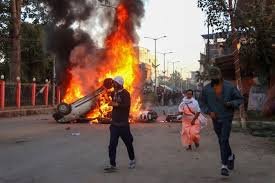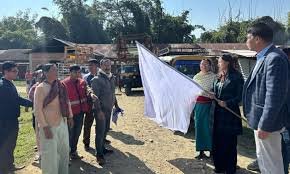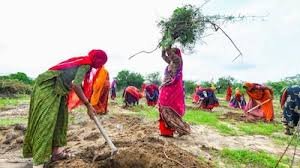From Bihar to Bengal, Assam to Delhi, BJP leaders are uniting around a single theme: the “infiltrator threat.” Analysts say this marks the party’s biggest ideological pivot since Ayodhya.
By Navin Upadhyay
August 23, 2025: For three decades, the Ram Janmabhoomi movement defined the ideological core of the Bharatiya Janata Party (BJP), shaping its mass mobilisations, elections, and eventual rise to political dominance. But with the Ayodhya temple issue largely settled following the consecration of the Ram Mandir in January 2024, the BJP appears to have shifted its primary political plank to a new axis—illegal immigration and cross-border infiltration.
The Prime Minister’s Pitch in Gaya
The campaign has now been elevated to the national stage. Prime Minister Narendra Modi, speaking at a rally in Gaya, Bihar, on Thursday, invoked the issue of “ghuspaithiyas” (illegal infiltrators), drawing a direct connection between infiltration, welfare burden, and national security.
“The increasing number of intruders in the country is a matter of concern. The demographic profile in Bihar’s border districts is changing rapidly, which is why the NDA government has decided that the future of the country will not be determined by infiltrators. We will not let infiltrators snatch job opportunities meant for the youth of Bihar, nor will we let them plunder the amenities that rightfully belong to Indian citizens.”
PM Modi Slams RJD, Congress; Warns of ‘Ghuspaithiya’ Threat https://t.co/bYc6DHUAZQ #ModiInBihar #Ghuspaithiya #BJPCampaign #RJD #Congress
— POWER CORRIDORS (@power_corridors) August 22, 2025
PM Modi Slams RJD, Congress; Warns of ‘Ghuspaithiya’ ThreatHis remarks suggest that immigration is set to become a central theme in the BJP’s campaign narrative ahead of the upcoming Assembly elections and possibly the 2029 Lok Sabha polls..”
The PM went on to target BJP’s political rivals by saying, “ “People of Bihar need to be aware of the supporters of these immigrants… Congress and RJD want to take away the rights of the people of Bihar and give them to immigrants for appeasement and to increase their vote bank.”
Ravi’s Warning at Delhi University
On the same day, Tamil Nadu Governor R N Ravi, a former Intelligence Bureau officer, amplified the discourse at Delhi University’s Vice-Regal Lodge during the inaugural session of Seema Vimarsh, a two-day international seminar on cross-border infiltration.
Ravi called the trend “a strategic project aimed at another partition of India.” He argued that the influx across Assam, Bengal, and other Northeastern states was not simply a case of economic migration but a calculated attempt to alter India’s demographic and cultural balance—something that military solutions alone could not address.
His remarks echoed the rhetoric of leaders like Himanta Biswa Sarma and former Manipur Chief Minister Biren Singh, offering a glimpse into the high-table discourse where the “political demands of the Kuki-Zo people” are increasingly framed through the Meitei narrative of illegal immigration.
READ: Biren Singh Labels Myanmar Entrants ‘Illegal’ Despite Biometrics
Bire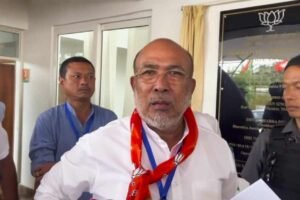 n Singh’s Shrill Cry
n Singh’s Shrill Cry
In Manipur, former Chief Minister N. Biren Singh keep invoking the issue of “illegal migrants” as a political plank, often framing it in ways that target the Kuki community. His consistent narrative linking Kukis with cross-border migration has further deepened ethnic divides in a state already scarred by two years of relentless violence and displacement. For many Kukis, who have lost homes, livelihoods, and loved ones, this rhetoric feels less like a security measure and more like a continuation of the stigmatization that has fueled their suffering.
Assam CM’s Singular Focus on the ‘Infiltrator’ Narrative
If there is one state where the BJP has doubled down most aggressively on the plank of illegal immigration, it is Assam. Chief Minister Himanta Biswa Sarma has virtually staked his entire political future on this narrative as the state heads towards Assembly elections next year.
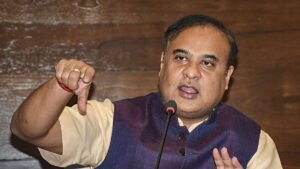
Over the past year, Sarma’s government has launched a series of eviction drives across districts such as Darrang, Hojai, and Nagaon, targeting settlements it claims are “illegally encroached by suspected migrants.” These actions, often carried out with heavy police deployment, have displaced thousands of families, sparking both domestic and international criticism. Yet Sarma has defended them as essential to protecting “Assamese land and identity.”
READ: Arunachal: Student Leader, Journalist Held in Drug Bust
Sarma has also escalated his rhetoric beyond state borders. In multiple public speeches, he has urged neighbouring states not to provide shelter to “Miyas”—a term colloquially used in Assam to refer to Bengali-speaking Muslims, often with pejorative undertones. By framing the issue as one of existential survival, Sarma has sought to consolidate ethnic Assamese sentiment and project himself as the most uncompromising defender of the state’s demographic integrity.
Party insiders admit that while development schemes and welfare programmes continue, Sarma’s 2026 Assembly campaign is being architected almost entirely around the infiltration issue. In BJP’s internal calculus, the “illegal immigrant” narrative is expected to galvanise Hindu voters across caste and class divides, much as the Ram Janmabhoomi movement once did nationally.
Critics argue that this relentless focus risks deepening social divides and alienating large sections of Assam’s population, particularly Muslims who constitute over a third of the state’s electorate. But for Sarma, the gamble is clear: make the battle against “infiltrators” the single defining message of his re-election campaign.
Bengal: Testing Ground for 2027
In West Bengal, where the BJP made significant electoral inroads in 2019 but failed to capture power in the 2021 Assembly polls, the party is once again sharpening the illegal immigration plank as it prepares for the 2027 elections.
Senior BJP leaders, including Amit Shah and Himanta Biswa Sarma, have repeatedly accused the Trinamool Congress (TMC) government of shielding “ghuspaithiyas” (infiltrators) for electoral gains. The party frames the issue as a matter of both national security and identity politics, warning that unchecked immigration from Bangladesh is altering the demographic balance in border districts such as North 24 Parganas, Malda, Murshidabad, and Cooch Behar.
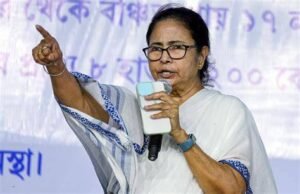
The narrative is being strategically tied to BJP’s long-standing push for the Citizenship Amendment Act (CAA) and a state-level National Register of Citizens (NRC). Party strategists believe that by foregrounding these demands, they can both consolidate Hindu voters who feel anxious about demographic shifts and corner the TMC as “soft” on infiltration.
In public meetings across North Bengal this year, BJP leaders have portrayed the 2027 polls as a “decisive battle” to protect Bengal’s cultural and demographic integrity. Posters and speeches highlight the alleged strain on welfare schemes, jobs, and land resources due to “illegal settlers.”
Observers note that the BJP’s Bengal strategy mirrors its Assam playbook—placing the “infiltrator threat” at the centre of electoral mobilisation. Whether this resonates in a state with a strong history of syncretic politics and regional identity remains to be seen, but the party’s messaging makes it clear: for Bengal 2027, illegal immigration will be the BJP’s primary campaign weapon.
Jharkhand and Delhi Campaigns
The same script reappeared in Jharkhand’s 2024 Assembly elections, with Himanta Biswa Sarma spearheading the charge. He warned that unchecked immigration was altering the state’s demographic balance and undermining tribal rights. In Delhi, BJP leaders raised the issue of “illegal colonies” and “unauthorised migrants” as part of the capital’s security and governance challenges.
From Religion to Demography
Analysts point out that the transition from Ram Janmabhoomi to illegal immigration as BJP’s central narrative reflects both political necessity and ideological evolution. With the temple issue resolved, the party has sought a fresh mobilising agenda that combines nationalism, security, and cultural identity.
“Illegal immigrants are being constructed as the new ‘other,’ replacing the religious mobilisation of the 1990s,” observes a political scientist at Jawaharlal Nehru University.
The focus on infiltration is expected to play out strongly in upcoming Assembly elections in Bihar, Jharkhand, and Assam, states where the BJP hopes to consolidate Hindu votes by framing illegal immigration as an existential threat. Critics, however, warn that this approach risks further polarising communities and stigmatising vulnerable migrant populations.
In effect, as the Ram Mandir shifts from agitation to celebration, the BJP’s political plank has evolved: the temple has been built, but the search for the next rallying cause continues. Illegal immigration, framed as both a security and cultural challenge, has now emerged as the party’s new fulcrum.




